胶结物
沉积学复习
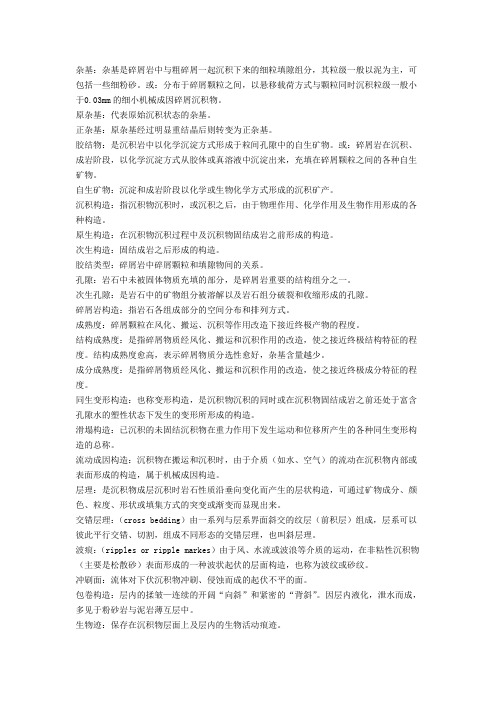
杂基:杂基是碎屑岩中与粗碎屑一起沉积下来的细粒填隙组分,其粒级一般以泥为主,可包括一些细粉砂。
或:分布于碎屑颗粒之间,以悬移载荷方式与颗粒同时沉积粒级一般小于0.03mm的细小机械成因碎屑沉积物。
原杂基:代表原始沉积状态的杂基。
正杂基:原杂基经过明显重结晶后则转变为正杂基。
胶结物:是沉积岩中以化学沉淀方式形成于粒间孔隙中的自生矿物。
或:碎屑岩在沉积、成岩阶段,以化学沉淀方式从胶体或真溶液中沉淀出来,充填在碎屑颗粒之间的各种自生矿物。
自生矿物:沉淀和成岩阶段以化学或生物化学方式形成的沉积矿产。
沉积构造:指沉积物沉积时,或沉积之后,由于物理作用、化学作用及生物作用形成的各种构造。
原生构造:在沉积物沉积过程中及沉积物固结成岩之前形成的构造。
次生构造:固结成岩之后形成的构造。
胶结类型:碎屑岩中碎屑颗粒和填隙物间的关系。
孔隙:岩石中未被固体物质充填的部分,是碎屑岩重要的结构组分之一。
次生孔隙:是岩石中的矿物组分被溶解以及岩石组分破裂和收缩形成的孔隙。
碎屑岩构造:指岩石各组成部分的空间分布和排列方式。
成熟度:碎屑颗粒在风化、搬运、沉积等作用改造下接近终极产物的程度。
结构成熟度:是指碎屑物质经风化、搬运和沉积作用的改造,使之接近终极结构特征的程度。
结构成熟度愈高,表示碎屑物质分选性愈好,杂基含量越少。
成分成熟度:是指碎屑物质经风化、搬运和沉积作用的改造,使之接近终极成分特征的程度。
同生变形构造:也称变形构造,是沉积物沉积的同时或在沉积物固结成岩之前还处于富含孔隙水的塑性状态下发生的变形所形成的构造。
滑塌构造:已沉积的未固结沉积物在重力作用下发生运动和位移所产生的各种同生变形构造的总称。
流动成因构造:沉积物在搬运和沉积时,由于介质(如水、空气)的流动在沉积物内部或表面形成的构造,属于机械成因构造。
层理:是沉积物成层沉积时岩石性质沿垂向变化而产生的层状构造,可通过矿物成分、颜色、粒度、形状或填集方式的突变或渐变而显现出来。
胶结物

1.定义:胶结物是碎屑岩在沉积、成岩阶段,以化学沉淀方式从胶体或真溶液中沉淀出来,充填在碎屑颗粒之间的各种自生矿物。
2.成因:化学沉淀3.常见的胶结物类型(1)硅质胶结物:蛋白石、玉髓、石英(2)碳酸盐胶结物:方解石、白云石、菱铁矿等(3)铁质胶结物:赤铁矿、褐铁矿(4)其它胶结物:粘土矿物、石膏、硬石膏、黄铁矿、磁铁矿、磷酸盐类矿物等泥质一般较软,如果填隙物多的话,可以看到贝壳状断口,比较滑,用手捻不会有沙质感,铁质一般颜色比较深,红褐色,硅质较硬,一般在石英、长石质石英砂岩中,沉积石英岩中,碎屑成份一般含石英较多,色浅(一般浅灰白,有铁染时呈肉红色),石英多时会看到岩石断面上的油脂光泽,钙质一般出现在碳酸盐岩地区,与硅质特征有些相近,但硬度较低,角砾成分也以碳酸盐为主。
泥质、铁质、钙质、硅质胶结物在显微镜下简单的能区别,但是铁质和钙质区分不开。
再说泥质可以有钙质也可以有铁质,楼主的问题也欠妥。
楼主是想区分胶结物形态呢还是想做胶结物的成分,但是我说得这些方法绝对有用,而不像5楼说得一物用处,我觉得你们还没接触这些方法,你可以和你们的导师探讨一下。
假设片中有大量碳酸盐胶结物不能确定类型,x射线显示为白云石,只需要鉴定其铁含量就能确定矿物,当然如果连胶结物都不认识,x射线显示石英,你非把这个做胶结物,那就没办法了。
阴极发光也是同样道理,首先你得知道,哪些是胶结物,哪些不是,在加以判断,在阴极发光下铁含量高的胶结物一般发红色光;镁含量高的胶结物一般发橙色光;菱铁矿发橙红色光;方解石发黄色-橙色光;白云石暗红色光,铁白云石不发光;菱镁矿橙色光。
人工方解石,颜色偏粉一些,这些很多科研和外协项目都是通过这些手段区分胶结物的。
茜素红是典型的也是最简单的区分碳酸盐的方法:胶结物方解石遇S茜素红,变粉红-红,颜色深浅由方解石中铁含量决定;白云石遇S茜素红不变色;铁白云石变蓝色;菱铁矿不变色。
菱铁矿和白云石就得配合阴极发光,菱铁矿和白云石发光不同。
《油层物理学》第5节:储层岩石的敏感性研究
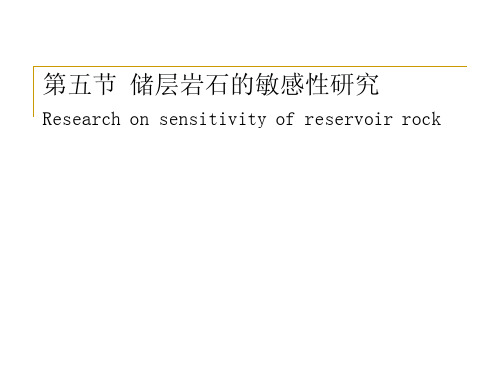
油藏物理学——储层岩石的敏感性研究
华北坳陷第三系:
接触胶结中的φ:23~30%,K:(50~1000)×10-3μm2 孔隙胶结中的φ:18~25%,K:(1~150)×10-3μm2 基底胶结中的 φ:8~17%, K < 1×10-3μm2
油藏物理学——储层岩石的敏感性研究
5. 影响粘土膨胀的因素:effect factor on clay swelling 粘土类型 clay type 含量 clay content 分布clay distribution 水的矿化度 water saltiness/salinity 阳离子交换性cation exchange
第五节 储层岩石的敏感性研究
Research on sensitivity of reservoir rock
油藏物理学——储层岩石的敏感性研究
讲课提纲
一. 问题的提出 二. 胶结物与胶结类型 三. 敏感矿物
●水敏性矿物 ●盐敏性矿物 ●酸敏性矿物 ●碱敏性矿物 ●速敏性矿物 ● 盐敏 四. 储层敏感性的评价方法 ●推荐程序 ●试验流程 ●发展趋势
油藏物理学——储层岩石的敏感性研究
(1)粘土遇水膨胀 ― 水敏性矿物
Clay swelling ——water sensitivity mineral 1. 起因:晶层间联系的牢固性 水敏性矿物由于其在晶层间的吸水引起的膨 胀,砂粒上的粘土颗粒的絮解和在粘土片外表形 成的定向水化层。
如:蒙脱石是硅氧四面体结构,晶层间的 距离与所嵌离子的离子半径的差会引起阳离子 的交换,或水分子的进入,因而引起膨胀。
油藏物理学——储层岩石的敏感性研究
沉积岩名词解释

名词解释1、sedimentary rock:沉积岩是组成岩石圈的三大类岩石(岩浆岩、变质岩、沉积岩)之一。
它是在地壳表层的条件下,由母岩的风化产物、火山物质、有机物质、宇宙物质等沉积岩的原始物质成分,经过搬运作用、沉积作用以及沉积后作用而形成的一类岩石。
3、结构成熟度:指碎屑物质结构上被改造趋向于最终产物的程度。
等大分选好圆状球形无杂基。
4、纹层:组成层里的最基本的最小的单位,纹层之内没有任何肉眼可看见的层,也成为细层。
5、鲕粒:具有核心和同心层结构的球状颗粒,像鱼子,大小2~0.25mm,常见的为1~0.5mm。
6、盐岩:指由于含盐度较高的溶液和卤水,通过蒸发作用产生化学程佃而形成的岩石,它们的主要组分都是盐类矿物,也就是蒸发岩。
7、成分成熟度::指碎屑物质成分上被改造趋向于最终产物的程度,亦称“化学成熟度”或“矿物成熟度”。
8、板状交错层理:层系之间的界面为平面而且彼此平行,纹层与层系界面斜交。
大型板状交错层理在河流沉积中最为典型。
9、胶结物:碎屑岩中以化学沉淀方式形成于粒间孔隙中的自生矿物10、硅岩:主要指自生二氧化硅含量达70%~80%的沉积岩,不包括主要碎屑石英组成的石英砂岩和石英岩。
11、重矿物(heavy mineral):风化稳定性的差别很大,如锆石、金红石、电气石等较稳定,为沉积岩中常见的稳定重矿物。
12、母岩:是供给沉积岩原始物质成分的岩石,包括岩浆岩、变质岩和早已形成的沉积岩。
13、埋藏成岩作用(buried diagenesis):碎屑沉积物随埋深增加,主要由于机械压实作用和化学胶结作用,致使岩石逐渐变致密、孔隙度减小、物性变差等一系列物理和化学变化直到变质作用。
14沉积后作用(postsedimentation process):泛指沉积物形成以后到沉积岩遭受风化作用和变质作用以前这一演化阶段的所有变化和作用。
15同生作用(syngenesis):指沉积物刚刚形成以后而尚与上覆水体相接触时的变化。
碎屑岩的成分

3、铁质胶结:赤铁矿、褐铁矿。
砂岩中的氧化铁物质,一部分是与碎屑颗 粒同时从溶液中沉淀出来的原始孔隙充填物 (即沉积~同生阶段生成的)。另一部分铁质 是含铁矿物在成岩作用过程中不断被孔隙水分 解,从而将氧化铁释放出来。
(一) 矿物碎屑:
目前已发现的碎屑矿物约有160多种、最常见 的约20种。但在一种碎屑岩中,其主要碎屑矿物通 常不过3~5种。
1、 石英:
石英抗风化能力很强,既抗磨又难分解,同时 在大部分岩浆岩和变质岩中石英含量又高,因此, 石英是碎屑岩中分布最广的一种碎屑矿物,尤其 在较细的碎屑岩(砂岩及粉砂岩)中含量相当高 (平均含量可达66.8%)。
石英在沉积岩中,一般呈不规则粒状,完整晶 形极少见,灰白或烟灰色、常因胶结物的浸染光 泽不明显。
(1)来自深成岩浆岩的石英:
来自中酸性深成岩的石英,常含有细小的液体、
气体包裹体,或含一些岩浆岩副矿物包裹体,很浑
浊。常表现明显的波状消光 。
矿物包裹体
颗粒细小,
自形程度高,
排列无一定
方位。尘状
气、液包裹
(三)盆内碎屑:
盆内碎屑是指在盆地内生成的碎屑,不是陆地搬 运来的(但其物质成分可以是陆源的)。相对于陆源 碎屑而言,盆内碎屑又称为内源碎屑。
盆内碎屑主要是:碳酸盐鲕粒、化石碎屑、泥质 内碎屑、球粒、内碎屑等。
(四)碎屑岩中颗粒大小与碎屑成分之间的相互关系:
二、化学沉淀物质:胶结物和自生矿物。
(一)自生矿物:指在同生、成岩、后生阶段生 成的矿物。
自生矿物的特点:自生矿物可形成于不同的阶段、 不同的介质环境。但其共同特点是:成分一般较单一、 结晶颗粒较小,清洁透明、晶形完好。
《沉积岩石学》第三章 碎屑岩的成分

表3—8 化学成分与粒度的关系(引自裴蒂庄,1975)
组成 SiO2 TiO2
AL2O3 氧化铁 MgO
CaO Na2O K2O
细砂 71.15 0.50 10.16 3.72 1.66 3.65 0.86 2.20
粉砂 61.24 0.85 13.30 3.94 3.31 5.11 1.32 2.33
镇川1井,h8,黑云母受压变形 100倍
3、重矿物
指碎屑岩中比重大于2.86的矿物。
在岩石中含量很少,一般<1%,主要分布在在0.25~ 0.05mm的粒级范围内(细砂—粗粉砂岩) 根据风化稳定性
稳定重矿物
电气石、锆英石、金红石、石榴石、榍石、磁 铁矿 等
不稳定重矿物
重晶石、磷灰石、绿帘石、黄铁矿等
长石砂岩中,砾岩、粉砂岩中含量较少。
(2)来源:主要来自花岗岩、花岗片麻岩 (3)长石大量出现的有利因素:
地壳运动比较剧烈,地形高差大,气候干燥, 物理风化作用为主,搬运距离近,快速堆积。
(4)稳定性:钾长石>钠长石>钙长石;正长石>微 斜长石。
长石
斜长石,白云石胶结,细砂岩,东濮,100(+)
锆石,石榴石,角闪石
各类岩石的轻重矿物组合
母岩 花岗岩 花岗闪长岩 安山岩和玄武
岩 橄榄岩和辉长
岩 变质岩
沉积岩
重矿物 轻矿物 重矿物 轻矿物 重矿物 轻矿物 重矿物 轻矿物
重矿物
轻矿物
矿物组合(包括部分岩屑) 锆石 金红石 榍石 磷灰石 黑云母 石英 正长石 微斜长石 酸性斜长石
辉石 角闪石 安山岩或玄武岩岩屑 中性和基性斜长石
碎屑岩的成分可以用其所含的矿物成分表示,也可用化学成 分表示。
砾岩的胶结类型
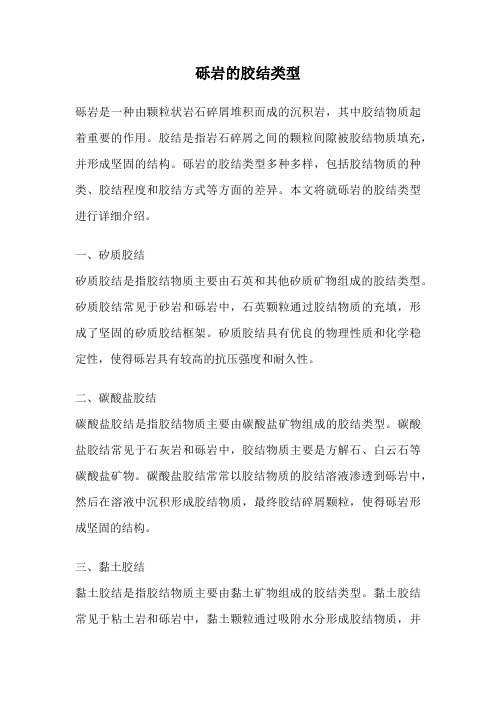
砾岩的胶结类型砾岩是一种由颗粒状岩石碎屑堆积而成的沉积岩,其中胶结物质起着重要的作用。
胶结是指岩石碎屑之间的颗粒间隙被胶结物质填充,并形成坚固的结构。
砾岩的胶结类型多种多样,包括胶结物质的种类、胶结程度和胶结方式等方面的差异。
本文将就砾岩的胶结类型进行详细介绍。
一、矽质胶结矽质胶结是指胶结物质主要由石英和其他矽质矿物组成的胶结类型。
矽质胶结常见于砂岩和砾岩中,石英颗粒通过胶结物质的充填,形成了坚固的矽质胶结框架。
矽质胶结具有优良的物理性质和化学稳定性,使得砾岩具有较高的抗压强度和耐久性。
二、碳酸盐胶结碳酸盐胶结是指胶结物质主要由碳酸盐矿物组成的胶结类型。
碳酸盐胶结常见于石灰岩和砾岩中,胶结物质主要是方解石、白云石等碳酸盐矿物。
碳酸盐胶结常常以胶结物质的胶结溶液渗透到砾岩中,然后在溶液中沉积形成胶结物质,最终胶结碎屑颗粒,使得砾岩形成坚固的结构。
三、黏土胶结黏土胶结是指胶结物质主要由黏土矿物组成的胶结类型。
黏土胶结常见于粘土岩和砾岩中,黏土颗粒通过吸附水分形成胶结物质,并填充砾岩颗粒之间的间隙,形成胶结结构。
黏土胶结具有较强的胶结性能,但其抗压强度较低,易受水分变化影响。
四、铁质胶结铁质胶结是指胶结物质主要由铁氧化物和其他铁质矿物组成的胶结类型。
铁质胶结常见于铁岩和砾岩中,铁质矿物通过胶结物质的充填和胶结,形成了坚固的铁质胶结框架。
铁质胶结具有较高的抗压强度和耐久性,但容易受到氧化和腐蚀的影响。
五、胶结程度砾岩的胶结程度指的是胶结物质与岩石碎屑之间的充填程度。
胶结程度可分为强胶结、中等胶结和弱胶结三种类型。
强胶结指胶结物质完全填充了岩石碎屑之间的间隙,形成了坚固的结构;中等胶结指胶结物质部分填充了岩石碎屑之间的间隙,结构较为稳定;弱胶结指胶结物质仅在岩石碎屑之间形成了薄薄的胶结层,结构较为松散。
六、胶结方式砾岩的胶结方式主要包括晶间胶结、胶结溶液渗透胶结和胶结物质沉积胶结三种类型。
晶间胶结指胶结物质以晶体形式填充了岩石碎屑之间的间隙;胶结溶液渗透胶结指胶结物质通过胶结溶液的渗透充填了岩石碎屑之间的间隙;胶结物质沉积胶结指胶结物质通过溶液中的沉积过程形成了胶结结构。
油层物理名词解释

一、名词解释:Absolute permeability:P239绝对渗透率:岩心中100%被一种流体所饱和时测定的渗透率。
Acid sensitive:岩石酸敏性:酸敏性是指酸化液进入地层后与地层中的酸敏性矿物发生反应,产生凝胶、沉淀或释放出微粒,使地层渗透率下降的现象。
Adhesive power:粘附功:非湿相流体中,将单位面积的湿相从固体界面拉开所作的功。
Adsorption:吸附作用:溶解于某一相中的物质,自发地聚集到两相界面层并急剧减低该界面层的表面张力的现象称之为吸附。
Average production oil/gas ratio:平均生产油气比:Bubble point pressure:泡点压力:温度一定时,压力降低过程中开始从液相分离出第一批气泡时的压力。
Capillary hysteresis:毛细管滞后现象:在其他条件相同的情况下,由于饱和顺序不同,毛细管中吸入过程产生的液柱高度小于驱替过程产生的液柱高度。
Capillary number:P256毛管数:油滴上的动力与阻力之比。
ΔP/LδCapillary pressure curve:毛细管压力曲线:用实验的方法测量出不同湿相流体的饱和度下的毛细管压力与湿相(非湿相)饱和度的关系曲线。
Cement:胶结物:除砂岩碎屑颗粒以外的化学沉淀物质。
Cementing types:胶结类型:胶结物在岩石中的分布状态以及他们与碎屑颗粒的接触关系。
包括基底式胶结、孔隙式胶结、接触式胶结。
Clay mineral:粘土矿物:高度分散的含水的层状硅酸盐和含水的非晶质硅酸盐矿物的总称。
Composition of a system:p47体系的组成:体系中所含组分以及各组分在总体系中所占的比例。
Compressibility factor of natural gas:天然气的压缩系数:给定压力和温度下,一定量真实气体所占的体积与相同温度、压力下等量理想气体所占有的体积之比。
鲕粒灰岩胶结特征

鲕粒灰岩胶结特征鲕粒灰岩是一种特殊的岩石,其胶结特征使其在地质学和建筑材料方面具有重要的应用价值。
鲕粒灰岩是一种由碳酸盐矿物组成的岩石,其主要成分是方解石和镁方解石。
鲕粒灰岩的颗粒大小在0.2毫米至2毫米之间,形状呈圆球状或卵圆状,因此得名。
鲕粒灰岩的胶结特征主要表现为胶结物填充颗粒之间的空隙,使岩石具有一定的强度和稳定性。
胶结物主要由碳酸盐矿物、黏土矿物和铁氧化物等组成。
这些胶结物通过化学反应和物理作用将颗粒牢固地连接在一起,形成坚硬的岩石结构。
鲕粒灰岩的胶结特征对其物理和力学性质有着重要影响。
首先,胶结物的存在增加了岩石的密度,使其比一般的灰岩更加坚硬和耐久。
其次,胶结物填充了颗粒之间的空隙,减少了孔隙度,提高了岩石的密实性和强度。
此外,胶结物还可以改善岩石的抗风化性能,减少了岩石受到水、气候和化学侵蚀的影响。
鲕粒灰岩的胶结特征还对其在建筑材料方面的应用产生了重要影响。
由于胶结物填充了颗粒之间的空隙,使得鲕粒灰岩具有较好的抗压强度和抗冻融性能,因此被广泛应用于建筑材料中。
鲕粒灰岩制成的砖块、板材和地面砖具有较高的强度和耐久性,可以用于建造高层建筑、桥梁和道路等工程。
此外,鲕粒灰岩还具有一定的装饰价值。
由于其颗粒呈现出均匀而细腻的特点,可以制成各种装饰材料,如雕塑、地板和墙壁等。
这些装饰材料不仅具有美观的外观,而且具有较好的耐用性和抗污染性能,因此在室内装饰中得到了广泛应用。
总之,鲕粒灰岩的胶结特征使其在地质学和建筑材料方面具有重要的应用价值。
通过深入研究和开发利用其胶结特征,可以进一步发挥其在建筑材料领域的潜力,为人们提供更好的建筑和装饰材料。
常见岩石、矿物、胶结物、元素英汉对照

常见岩石、矿物、胶结物、元素:岩石:u Magmatite,Magmatic rock(岩浆岩)/Igneous(火成岩),u Plutonic(深成岩),u Gabbro (辉长岩),u Diabase(辉绿岩),u Diorite (闪长岩),u Basalt (玄武岩) ,u Peridotite(橄榄岩),u Andesite (安山岩),,u Granite(花岗岩),u Gneiss (片麻岩) u Quartzite(石英岩),u Lamprophyre (煌斑岩) ,u Breccia(角砾岩),u Schist(片岩)u Metamorphic (变质岩),u Slate(板岩),u Argillite(泥质板岩、厚层泥岩),u Sedimentary rock (沉积岩),u Conglomerate(砾岩)/Gravel(砾岩、砂砾、碎石),u Clastic(碎屑岩),u Breccia(角砾岩),u Boulder(巨砾),u Cobble(粗砾),u Pebble(中砾),u Granule (细砾),u Very Coarse Sand(砾状砂\含粒状砂),u Coarse Sand (粗砂岩),u Medium Sand(中砂岩),u Fine Sand(细砂岩),u Very Fine Sand(粉细砂)/Sandy Siltstone (粉细砂、砂质粉),u Siltstone(粉砂岩),u Bentonite(膨润土、坂土),u Oil Shale, Pil Shale, Resinoid Shale (油页岩) ,u Clay(粘土),u Shale, Mudstone (泥岩),u Gumbo (Clay)(强粘土),u Limy Sand(石灰质砂岩),u Carbonate(碳酸盐岩),u Marble (大理岩),u Limestone(灰岩),u Sandy Lime(砂质灰岩),u Dolomite(白云岩),u Bio- limestone(生物灰岩) ,u Oolitic Limestone (鲕状灰岩),u Tuff (凝灰岩) ,u Clastic Limestone(碎屑灰岩),u Evaporite(蒸发岩),u Rock Salt(盐岩),u pelitic siltstone 泥质粉砂岩,u argillaceous limestone 泥质灰岩,u calcirudite砾屑灰岩矿物:u Quartz(石英),u Feldspar(长石),u Orthoclase/Syenite(正长石),u Plagioclase Feldspar(斜长石),u Potassium Feldspar(钾长石),u Mica(云母),u Biotite Mica (黑云母),u Dolomite(白云母),u Calcite(方解石),u Olivine(橄榄石),u Amphibole (角闪石),u Pyroxene(辉石),u Pumice(浮石),u Felsite (霏细石),u Fluorite(荧石),u Apatite(磷灰石),u Topaz(黄玉),u Corundum(刚玉),u Opal(蛋白石),u Garnet(锆石),u Garnet(石榴石),u Anhydrite(硬、无水石膏),u Gypsum(石膏),u Kaolinite(高岭石),u Illite(伊利石),u Magnetite/Ferromagnesian Mineral(磁铁矿),u Hematite(赤铁矿),u Pyrite(黄铁矿),u Halite(岩盐),u Chert(燧石、黑硅石)/Flint(燧石),u Glauconite(海绿石),u Barite(重晶石),u Sodium Chloride (NaCl),u Sulphur(硫),u Carbide(电气石,CaC2)胶结物:u Calcium,Limy,Calcareous(灰质),u Dolomite(白云质),u Silicon(硅质),Silica(SiO2),u Gypsum(石膏)/Anhydrite(硬、无水石膏)----(石膏质),u Ferrous(铁质)----Iron,u Quartz Cement(石英胶结物),u Clay Cement(粘土胶结物),u Kaolinite(高岭石)----高岭土质,u Argillaceous(泥质)----Mud,Clay。
沉积岩石学 名词解释 (超全)考试必备

1.沉积岩:在地壳表层的条件下,由母岩的风化产物、火山物质、有机物等沉积岩的原始物质成分,经过搬运作用、沉积作用以及沉积后作用形成的一类岩石。
2.风化作用:是地壳表层岩石的一种破坏作用。
引起岩石破坏的外界因素有温度的变化水以及各种酸的溶蚀作用生物的作用以及各种地质营力的剥蚀作用3.层流:一种缓慢流动的流体,作有条不紊的平行现状运动,彼此不相掺混。
4.紊流:充满了漩涡的多湍流的流体,流体质点的运动轨迹极不规则,其流速大小和流动方向随时间而变化,彼此相互掺混。
5.沉积后作用:泛指沉积作用以后到沉积岩的风化作用和变质作用以前这一演化阶段的所有变化和作用6.同生作用:指沉积物刚刚形成以后而且尚与上覆水体相接触时的变化7.准同生作用:主要是指潮上带的疏松碳酸钙沉积物被高镁粒间水白云化的作用8.碎屑岩:由碎屑成分和填隙物成分(包括杂基和胶结物)组成,其中碎屑成分占50%以上9.岩屑:是母岩岩石的碎块是保持着母岩结构的矿物集合体10.成分成熟度:是指以碎屑岩中最稳定的组分的相对含量来标志起成分的成熟程度。
11.结构成熟度:指碎屑岩沉积物在风化、搬运、沉积作用的改造下接近终极构造的特征程度(颗粒圆度、球度、分选性程度、杂基含量)。
12.杂基:碎屑岩中细小的机械成因组分,基粒级以泥级为主,可包括一些细粉砂。
13.胶结物:碎屑岩中以化学沉淀方式形成于粒间空袭中的自生矿物。
14.碎屑岩的结构:指构成碎屑岩的矿物和岩石碎屑的大小、形状、填隙物的结构以及不同组分的空间组合关系。
15.球度:用来衡量一个颗粒近于球体程度的一个定量参数。
分为圆球体椭球体扁球体长扁球体。
16.圆度:指碎屑颗粒的原始棱角被磨圆的程度,是碎屑颗粒的重要结构特征。
分为棱角状次棱角状次圆状圆状17.表面结构:是碎屑颗粒表面的形态特征,一般主要观察表面的磨光程度与表面的刻蚀痕迹两个方面。
18.沉积岩构造:指沉积岩的各个组成部分之间的空间分布和排列方式,它是沉积物在沉积期或沉积后通过物理作用、化学作用和生物作用形成的。
沉积岩胶结.

泥质胶结:灰-灰黄色,小刀很容易刻动,刻下来的粉末仍为灰色-黄色。
加酸(一般是稀盐酸),不起泡。
泥质胶结物:如泥土或粘土,其胶结层的岩石硬度较小,易碎,断面呈土状。
钙质胶结:灰-浅灰-灰白色,小刀容易刻动,刻下来的粉末为灰白色。
加酸剧烈起泡。
钙质胶结物:胶结物的成分为钙质,所胶结的岩石硬度比泥质胶结的岩石大一些,呈灰白色,滴稀盐酸起泡。
硅质胶结:灰白色,小刀不能刻动,锤击出来的粉末为灰白色。
加酸(一般是稀盐酸),不起泡。
硅质胶结物:胶结物成分为二氧化硅,所胶结的岩石硬度比前两种胶结物形成的岩石都大,呈灰色。
铁锰质胶结:一般为暗红色,小刀很容易刻动,刻下来的粉末仍为暗红色,加酸不起泡。
断口特征也能签定,泥质胶结粗糙、钙质胶结较平有时贝壳状、硅质胶结光亮、铁锰质胶结较粗糙。
有经验的一眼就能看出来。
铁质胶结物:胶结物成分为氢氧化铁或三氧化二铁,所胶结的岩石硬度也较大,常呈黄褐色或砖红色。
初学碎屑岩薄片鉴定的人,很容易把胶结物结构和胶结类型的概念相混淆。
在对碎屑岩进行薄片鉴定时,首先要搞清楚什么是杂基的结构,什么是胶结物的结构,而薄片鉴定表的结构栏里填写的则是胶结类型。
一、杂基和胶结物的结构碎屑岩的填隙物是由杂基和胶结物组成的,其支撑类型分两种:1、杂基支撑型:碎屑颗粒彼此不相接触而呈游离状。
填隙物多以粘土杂基为主,有时也指很细小的粉砂级,也常见灰泥、云泥杂基,它们是与颗粒同时沉积的。
这种支撑类型可能反映了一种特殊的水流机制,如重力流等。
杂基的结构主要表现为重结晶程度,如杂基没有明显的重结晶时,则称为原杂基;如果具明显的重结晶则成为正杂基。
2、颗粒支撑型:颗粒直接接触或细颗粒支撑大颗粒,形成支架结构。
填隙物有杂基也有胶结物。
胶结物是化学成因物质,它的结构与化学岩的结构类似,其特点是由晶粒大小、晶体生长方式及重结晶程度等决定的。
在碎屑岩中,胶结物的含量总小于50%。
胶结物的结构比较多样:1)按结晶程度分为:非晶质胶结物:如蛋白石及磷酸盐矿物等,它们在偏光显微镜下表现为均质体性质;显晶质胶结物:胶结物呈结晶粒状分布于碎屑颗粒之间。
胶结物结构

滨 海沉积 和风成 沉积的 碎屑物 质分选 好;而 洪流及 冰川沉 积分选 差。
3、 概率累积曲线: 仍然用累积重量百分 比作图。横坐标仍为粒 径(φ值),而纵坐标 改用概率百分数标度, 这样做成的便是概率值 累积曲线图。
概率坐标不是等间距 的,而是以中央50%处为 对称中心,向上、下两端 相应地逐渐加大,这样可 将粗、细尾部放大,并清 楚地表示出来。
2、累积曲线: 作累积曲线时,横坐 标仍表示粒径,而纵坐标 则表示各粒级的累积百分 含量。 作图时从粗粒级的一 端开始向细粒级的一端依 次点出每一粒级的累积百 分含量,然后将各点以圆 滑曲线连接起来,即得累 积曲线。
累积曲线用途: 累积曲线用途:分析粒度分布特征,进而帮助区 分不同的沉积环境。 从累积曲线图上可看出曲线的陡缓和粒级分布 范围,进而判断分选的好坏。粒度范围窄,曲线陡, 表示分选好;反之亦然。 累积曲线总是成“S”形,但不同沉积环境形成 的碎屑沉积物,其累积曲线形态是有差别的,可以 用来区分不同的沉积环境。
二、胶结物结构: 胶结物是化学成因物质,它的结构特点是由晶粒 大小、晶体生长方式及重结晶程度等决定的。胶结物 常见的结构类型有如下几种: 1、非晶质及隐晶质结构: 非晶质常是蛋白石、磷酸盐、 铁质等;隐晶质为玉髓、隐 晶磷酸盐矿物。
2、显晶粒状 结构(b、c): 碳酸盐胶结 物常具有这种结 构。因晶粒较大, 在手标本上可以 分辨。
3、接触胶结: 颗粒之间呈点接触或线接触,胶 结物含量很少,分布于碎屑颗粒相互 接触的地方。 接触胶结亦为颗粒支撑结构。胶 结物可能是干旱气候带的砂层,因毛 细管作用,溶液沿颗粒间细缝流动并 沉淀形成的;或者是原来的孔隙式胶 结经地下水淋滤改造而造成。
4、镶嵌胶结: 颗粒之间由点接触发展为线接触、凹 凸接触,甚至形成缝合状接触。 镶嵌胶结亦为颗粒支撑。在成岩期 的压固作用下,特别是当压溶作用明显 时,砂质沉积物中的碎屑颗粒会更紧密 地接触从而形成镶嵌式胶结。
胶结物(cementation)==

1055.00 1055.23 1072.32 1072.64 1072.82 1073.28 1073.65 1076.24 1076.47 1076.88 1077.41 1078.38 1078.78 1079.00 1080.48 1421.51 1421.86 1422.19 1422.47 1423.03 1423.29 1423.47 1423.87 1424.37 1424.58 1424.93 1425.06 1425.57 1425.73 1427.46 1427.75 1428.17 1428.47 1428.91 1429.2
JH9-9 JH9-10 JH9-12 JH9-13 JH9-14 JH9-15 JH9-17 JH9-18 JH9-19 JH9-20 JH9-22 JH9-23 JH9-24 JH9-25 JH9-27 JH13-2 JH13-3 JH13-4 JH13-5 JH13-7 JH13-8 JH13-9 JH13-10 JH13-12 JH13-13 JH13-14 JH13-15 JH13-17 JH13-18 JH13-19 JH13-20 JH13-22 JH13-23 JH13-24 JH13-25
长811 长811 长812 长812 长812 长812 长812
长812 长812 长813 长813 长813 长813 长813 长813 长813 长813 长813 长813 长813 长813 长813 长811 长811 长811 长811 长811 长811 长811 长811 长811 长811 长811 长811 长811 长811 长812 长812 长812 长812 长812 长812
23 16 1 2 2 13 8 1 2 2 3 0 0 3 3 2 2 17 4 11 10 14 0 0 21 12 0 3 5 14 5 0 2 1 1 6.7
沉积岩与沉积相相关知识汇总
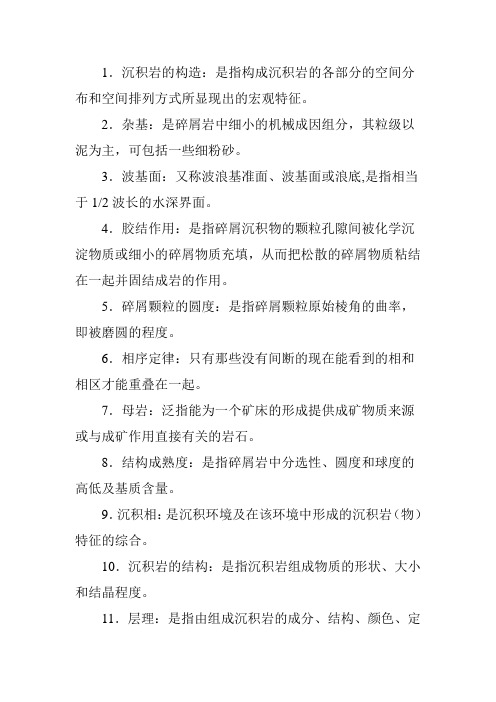
1.沉积岩的构造:是指构成沉积岩的各部分的空间分布和空间排列方式所显现出的宏观特征。
2.杂基:是碎屑岩中细小的机械成因组分,其粒级以泥为主,可包括一些细粉砂。
3.波基面:又称波浪基准面、波基面或浪底,是指相当于1/2波长的水深界面。
4.胶结作用:是指碎屑沉积物的颗粒孔隙间被化学沉淀物质或细小的碎屑物质充填,从而把松散的碎屑物质粘结在一起并固结成岩的作用。
5.碎屑颗粒的圆度:是指碎屑颗粒原始棱角的曲率,即被磨圆的程度。
6.相序定律:只有那些没有间断的现在能看到的相和相区才能重叠在一起。
7.母岩:泛指能为一个矿床的形成提供成矿物质来源或与成矿作用直接有关的岩石。
8.结构成熟度:是指碎屑岩中分选性、圆度和球度的高低及基质含量。
9.沉积相:是沉积环境及在该环境中形成的沉积岩(物)特征的综合。
10.沉积岩的结构:是指沉积岩组成物质的形状、大小和结晶程度。
11.层理:是指由组成沉积岩的成分、结构、颜色、定向性等性质在垂向上的变化所显示出来的特征。
12.粉砂岩:主要由0.1~0.01mm粒级(含量大于50%)的碎屑颗粒组成的细粒碎屑岩。
13.风化壳:地壳表层的岩石经长期风化作用后,有规律地残留在风化母岩的表面,构成一个大致连续而各地厚薄不一的层圈。
14.沉积岩的自生色:是指在准同生、共生和成岩期,在沉积物内形成的自生矿物所造成的颜色。
15.成分成熟度:是指以碎屑岩中最稳定组分的相对含量来标志其成分的成熟程度的指标。
16.砾岩:是指含有大量砾石级颗粒(含量大于30%)的碎屑岩。
17.内碎屑:指沉积盆地中已沉积的弱固结或固结的碳酸盐沉积物,经波浪、潮汐等水流作用冲刷、破碎、磨蚀、搬运、再沉积而形成的颗粒。
18.牛轭湖:弯曲河流的截弯取直作用使被截掉的弯曲河道废弃,形成牛軛湖。
19.渗透率:表示岩石在一定的压差下使流体通过的能力,单位为达西(D)20.砂岩:是指由含量50%以上、粒径在2~0.1mm之间的碎屑组成的碎屑岩。
胶结物结构

滨 海沉积 和风成 沉积的 碎屑物 质分选 好;而 洪流及 冰川沉 积分选 差。
3、 概率累积曲线: 仍然用累积重量百分 比作图。横坐标仍为粒 径(φ值),而纵坐标 改用概率百分数标度, 这样做成的便是概率值 累积曲线图。
概率坐标不是等间距 的,而是以中央50%处为 对称中心,向上、下两端 相应地逐渐加大,这样可 将粗、细尾部放大,并清 楚地表示出来。
一 、 粒 度 参 数 和 粒 度 资 料 图 解 : (一)粒度资料图解: 常用的粒度曲线包括:直方图、频率曲线、累 积曲线及概率累积曲线。 1、直方图和频率曲线: (1)直方图:是以横坐标表示颗粒的粒径区 间(φ),纵坐标表示粒级的百分含量(算数百分 比)而作出一系列相互连接、高低不平的矩形图。 每个矩形底边的长度代表粒度区间,高度代表各 粒度区间的重量百分比(频数)。
二、支撑结构: 碎屑结构的支撑类型可划分为两类,即杂基支撑结 构和颗粒支撑结构。 1、杂基支撑结构:杂基含量高,颗粒在杂基中呈 漂浮状。 它代表了一种快速堆积的产物,未遭受多少水流或 波浪的改造作用,细小的基质未被簸扬掉。如冰川堆 积、冲积扇沉积以及浊流沉积常见这种结构类型。 2、 颗粒支撑结构:碎屑颗粒彼此相互接触。 它是水流(波浪)持续作用的结果,细小的基质 已大部分被簸扬掉了。如沿岸砂坝、砂滩和风成沉积 常见此种结构类型。
细切 点
悬浮组分 跳跃组分
粗切 点
滚动组分
累积概率曲线一般为 三段式: 滚动组分、跳跃组分 和悬浮组分。 每个直线段需要有4个 以上的点构成。 概率累积曲线的主要结构 参数: 粗切点 粗切点:表示能跳 跃的最粗颗粒(水动力强 则粗切点左移);细切点 细切点: 细切点 表示能悬浮的最粗颗粒。 分选性:以每个直线 分选性 段的陡缓反映分选好坏。 线段陡(>500~600)分选 好,线段平缓(200~300) 分选差。
地层胶结类型
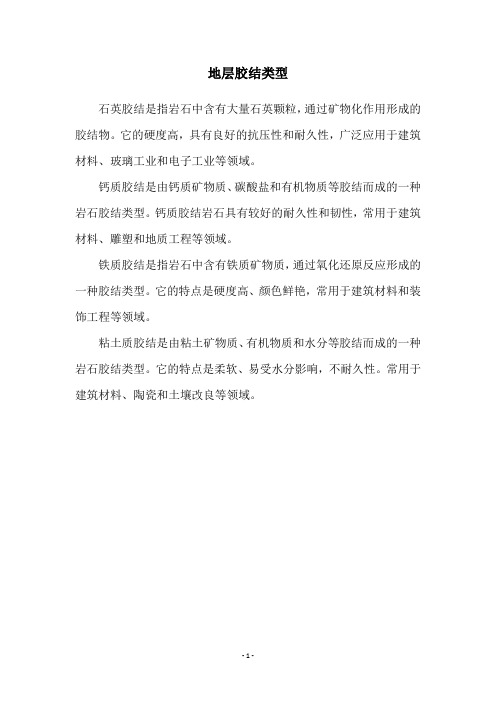
地层胶结类型
石英胶结是指岩石中含有大量石英颗粒,通过矿物化作用形成的胶结物。
它的硬度高,具有良好的抗压性和耐久性,广泛应用于建筑材料、玻璃工业和电子工业等领域。
钙质胶结是由钙质矿物质、碳酸盐和有机物质等胶结而成的一种岩石胶结类型。
钙质胶结岩石具有较好的耐久性和韧性,常用于建筑材料、雕塑和地质工程等领域。
铁质胶结是指岩石中含有铁质矿物质,通过氧化还原反应形成的一种胶结类型。
它的特点是硬度高、颜色鲜艳,常用于建筑材料和装饰工程等领域。
粘土质胶结是由粘土矿物质、有机物质和水分等胶结而成的一种岩石胶结类型。
它的特点是柔软、易受水分影响,不耐久性。
常用于建筑材料、陶瓷和土壤改良等领域。
- 1 -。
- 1、下载文档前请自行甄别文档内容的完整性,平台不提供额外的编辑、内容补充、找答案等附加服务。
- 2、"仅部分预览"的文档,不可在线预览部分如存在完整性等问题,可反馈申请退款(可完整预览的文档不适用该条件!)。
- 3、如文档侵犯您的权益,请联系客服反馈,我们会尽快为您处理(人工客服工作时间:9:00-18:30)。
胶结物胶结物指成岩期在岩石颗粒之间起粘结作用的化学沉淀物引。
主要胶结物为硅质(石英、玉髓等)、碳酸盐矿物(方解石、白云石等),其次是铁质(赤铁矿、褐铁矿等),有时可见硫酸盐矿物(石膏、硬石膏等)、沸石类矿物(方沸石、浊沸石等)、粘土矿物(高岭石、水云母、绿泥石等)。
碎屑颗粒和基质之外的化学沉淀物质。
在碎屑岩中含量一般不超过50%,它对碎屑颗粒起胶结作用,使其变成坚硬的岩石。
粘结岩土颗粒或结构面的物质,有钙质、硅质铁质、泥质及可溶盐等。
分类:基底式胶结、孔隙式胶结、接触式胶结和镶嵌式胶结。
命名:在同一岩石中可出现二种以上的胶结物结构和胶结类型,可用复合命名法,如再生孔隙胶结、连生基底胶结等。
胶结类型指碎屑物与填隙物(包括胶结物及杂基)之间的关系。
胶结类型或叫支撑性质,它首先与碎屑颗粒与杂基的相对数量比例(即基粒比)有关,另一重要因素是颗粒之间的相互关系。
如当水动力强时,和碎屑同时沉积下来的杂基将被冲走,使碎屑颗粒彼此相接触,颗粒之间留有空隙,造成“颗粒支撑”的结构,成岩后形成化学胶结物的碎屑岩;如果水动力弱或介质为密度流时,大小碎屑与泥质一起沉淀,造成“杂基支撑”的结构,碎屑呈“游离状”分布于杂基之中,成岩后形成杂基填充的碎屑岩。
在成岩期的压固作用下,特别是当压溶作用明显时,砂质沉积物中的碎屑颗粒会更紧密地接触。
颗粒之间由点接触发展为线接触、凹凸接触,甚至形成缝合状接触。
这种颗粒直接接触构成的镶嵌式胶结,有时不能将碎屑与其硅质胶结物区分开,看起来像是没有胶结物,因此有人称之为无胶结物式胶结。
A cement is a binder, a substance used in construction that sets and hardens and can bind other materials together. The most important types of cement are used as a component in the production of mortar in masonry, and of concrete- which is a combination of cement and an aggregate to form a strong building material.Cements used in construction can be characterized as being either hydraulic or non-hydraulic, depending upon the ability of the cement to set in the presence of water (see hydraulic and non-hydraulic lime plaster).Non-hydraulic cement will not set in wet conditions or underwater; rather, it sets as it dries and reacts with carbon dioxide in the air. It can be attacked by some aggressive chemicals after setting.Hydraulic cements(e.g., Portland cement) set and become adhesive due to a chemical reaction between the dry ingredients and water. The chemical reaction results in mineral hydrates that are not very water-soluble andso are quite durable in water and safe from chemical attack. This allows setting in wet condition or underwater and further protects the hardened material from chemical attack. The chemical process for hydraulic cement found by ancient Romans used volcanic ash (activated aluminium silicates[citation needed]) with lime (calcium oxide).The word "cement" can be traced back to the Roman term opus caementicium, used to describe masonry resembling modern concrete that was made from crushed rock with burnt lime as binder. The volcanic ash and pulverized brick supplements that were added to the burnt lime, to obtain a hydraulic binder, were later referred to as cementum, cimentum, cäment, and cement.CaCO3→ CaO + CO2The calcium oxide is then spent (slaked) mixing it with water to make slaked lime (calcium hydroxide):CaO + H2O → Ca(OH)2Once the excess water is completely evaporated (this process is technically called setting), the carbonation starts:Ca(OH)2 + CO2→ CaCO3 + H2OThis reaction takes a significant amount of time because the partial pressure of carbon dioxide in the air is low. The carbonation reaction requires the dry cement to be exposed to air, and for this reason the slaked lime is a non-hydraulic cement and cannot be used under water. This whole process is called the lime cycle.Conversely, hydraulic cement hardens by hydration when water is added. Hydraulic cements (such as Portland cement) are made of a mixture of silicates and oxides, the four main components being:Belite (2CaO·SiO2);Alite (3CaO·SiO2);Tricalcium aluminate (3CaO·Al2O3) (historically, and stilloccasionally, called 'celite');Brownmillerite (4CaO·Al2O3·Fe2O3).Cements in the 20th centuryThe National Cement Share Company of Ethiopia's new plant in Dire Dawa.Calcium aluminate cements were patented in 1908 in France by Jules Bied for better resistance to sulfates.In the US, the long curing time of at least a month for Rosendale cement made it unpopular after World War One in the construction of highways and bridges and many states and construction firms turned to the use of Portland cement. Because of the switch to Portland cement, by the end of the 1920s of the 15 Rosendale cement companies, only one had survived. But in the early 1930s it was discovered that, while Portland cement had a faster setting time it was not as durable, especially for highways, to the point that some states stopped building highways and roads with cement. Bertrain H. Wait, an engineer whose company had worked on the construction of the New York City's Catskill Aqueduct, was impressed with the durability of Rosendale cement, and came up with a blend of both Rosendale and synthetic cements which had the good attributes of both: it was highly durable and had a much faster setting time. Mr. Wait convinced the New York Commissioner of Highways to construct an experimental section of highway near New Paltz, New York, using one sack of Rosendale to six sacks of synthetic cement. It was proved a success and for decades the Rosendale-synthetic cement blend became common use in highway and bridge construction.[22]Portland cement[edit]Main article: Portland cementPortland cement is by far the most common type of cement in general use around the world. This cement is made by heating limestone (calcium carbonate) with other materials (such as clay) to 1450 °C in a kiln, in a process known as calcination, whereby a molecule of carbon dioxide is liberated from the calcium carbonate to form calcium oxide, orquicklime, which is then blended with the other materials that have been included in the mix to form calcium silicates and other cementitious compounds. The resulting hard substance, called 'clinker', is then ground with a small amount of gypsum into a powder to make 'Ordinary Portland Cement', the most commonly used type of cement (often referred to as OPC). Portland cement is a basic ingredient of concrete, mortar and mostnon-specialty grout. The most common use for Portland cement is in the production of concrete. Concrete is a composite material consisting of aggregate (gravel and sand), cement, and water. As a construction material, concrete can be cast in almost any shape desired, and once hardened, can become a structural (load bearing) element. Portland cement may be grey or white.Portland cement blends[edit]Portland cement blends are often available as inter-ground mixtures from cement producers, but similar formulations are often also mixed from the ground components at the concrete mixing plant.[26]Portland blast-furnace slag cement, or Blast furnace cement (ASTM C595 and EN 197-1 nomenclature respectively), contains up to 95% ground granulated blast furnace slag, with the rest Portland clinker and a little gypsum. All compositions produce high ultimate strength, but as slag content is increased, early strength is reduced, while sulfate resistance increases and heat evolution diminishes. Used as an economic alternative to Portland sulfate-resisting and low-heat cements.[27]Portland-fly ash cement contains up to 40% fly ash under ASTM standards (ASTM C595), or 35% under EN standards (EN 197-1). The fly ash is pozzolanic, so that ultimate strength is maintained. Because fly ash addition allows a lower concrete water content, early strength can also be maintained. Where good quality cheap fly ash is available, this can be an economic alternative to ordinary Portland cement.[28]Portland pozzolan cement includes fly ash cement, since fly ash is a pozzolan, but also includes cements made from other natural or artificial pozzolans. In countries where volcanic ashes are available (e.g. Italy, Chile, Mexico, the Philippines) these cements are often the most common form in use. The maximum replacement ratios are generally defined as for Portland-fly ash cement.Portland silica fume cement. Addition of silica fume can yield exceptionally high strengths, and cements containing 5–20% silica fume are occasionally produced, with 10% being the maximum allowed additionunder EN 197-1. However, silica fume is more usually added to Portland cement at the concrete mixer.[29]Masonry cements are used for preparing bricklaying mortars and stuccos, and must not be used in concrete. They are usually complex proprietary formulations containing Portland clinker and a number of other ingredients that may include limestone, hydrated lime, air entrainers, retarders, waterproofers and coloring agents. They are formulated to yield workable mortars that allow rapid and consistent masonry work. Subtle variations of Masonry cement in the US are Plastic Cements and Stucco Cements. These are designed to produce controlled bond with masonry blocks.Expansive cements contain, in addition to Portland clinker, expansive clinkers (usually sulfoaluminate clinkers), and are designed to offset the effects of drying shrinkage that is normally encountered with hydraulic cements. This allows large floor slabs (up to 60 m square) to be prepared without contraction joints.White blended cements may be made using white clinker (containing little or no iron) and white supplementary materials such as high-purity metakaolin.Colored cements are used for decorative purposes. In some standards, the addition of pigments to produce "colored Portland cement" is allowed. In other standards (e.g. ASTM), pigments are not allowed constituents of Portland cement, and colored cements are sold as "blended hydraulic cements".Very finely ground cements are made from mixtures of cement with sand or with slag or other pozzolan type minerals that are extremely finely ground together. Such cements can have the same physical characteristics as normal cement but with 50% less cement particularly due to their increased surface area for the chemical reaction. Even with intensive grinding they can use up to 50% less energy to fabricate than ordinary Portland cements.[30]Other cements[edit]Pozzolan-lime cements. Mixtures of ground pozzolan and lime are the cements used by the Romans, and can be found in Roman structures still standing (e.g. the Pantheon in Rome). They develop strength slowly, but their ultimate strength can be very high. The hydration products thatproduce strength are essentially the same as those produced by Portland cement.Slag-lime cements.Ground granulated blast-furnace slag is not hydraulic on its own, but is "activated" by addition of alkalis, most economically using lime. They are similar to pozzolan lime cements in their properties. Only granulated slag (i.e. water-quenched, glassy slag) is effective as a cement component.Supersulfated cements contain about 80% ground granulated blast furnace slag, 15% gypsum or anhydrite and a little Portland clinker or lime as an activator. They produce strength by formation of ettringite, with strength growth similar to a slow Portland cement. They exhibit good resistance to aggressive agents, including sulfate. Calcium aluminate cements are hydraulic cements made primarily from limestone and bauxite. The active ingredients are monocalcium aluminate CaAl2O4(CaO · Al2O3 or CA in Cement chemist notation, CCN) and mayenite Ca12Al14O33(12 CaO · 7 Al2O3, or C12A7 in CCN). Strength forms by hydration to calcium aluminate hydrates. They are well-adapted for use in refractory (high-temperature resistant) concretes, e.g. for furnace linings.Calcium sulfoaluminate cements are made from clinkers that includeye'elimite (Ca4(AlO2)6SO4or C4A3S in Cement chemist's notation) as a primary phase. They are used in expansive cements, in ultra-high early strength cements, and in "low-energy" cements. Hydration produces ettringite, and specialized physical properties (such as expansion or rapid reaction) are obtained by adjustment of the availability of calcium and sulfate ions. Their use as a low-energy alternative to Portland cement has been pioneered in China, where several million tonnes per year are produced.[31][32] Energy requirements are lower because of the lower kiln temperatures required for reaction, and the lower amount of limestone (which must be endothermically decarbonated) in the mix. In addition, the lower limestone content and lower fuel consumption leads to a CO2emission around half that associated with Portland clinker. However, SO2 emissions are usually significantly higher."Natural" cements correspond to certain cements of the pre-Portland era, produced by burning argillaceous limestones at moderate temperatures. The level of clay components in the limestone (around 30–35%) is such that large amounts of belite (the low-early strength, high-late strength mineral in Portland cement) are formed without the formation of excessive amounts of free lime. As with any natural material, such cements have highly variable properties.Geopolymer cements are made from mixtures of water-soluble alkali metal silicates and aluminosilicate mineral powders such as fly ash and metakaolin.Green cementGreen cement is a cementitious material that meets or exceeds the functional performance capabilities of ordinary Portland cement by incorporating and optimizing recycled materials, thereby reducing consumption of natural raw materials, water, and energy, resulting in a more sustainable construction material.New manufacturing processes for producing green cement are being researched with the goal to reduce, or even eliminate, the production and release of damaging pollutants and greenhouse gasses, particularly CO2.[56]Growing environmental concerns and increasing cost of fuels of fossil origin have resulted in many countries in sharp reduction of the resources needed to produce cement and effluents (dust and exhaust gases).[55]Peter Trimble, a design student at the University of Edinburgh has proposed 'DUPE' based on Sporosarcina pasteurii, a bacterium with binding qualities which, when mixed with sand and urine produces a concrete said to be 70% as strong as conventional materials.[57。
